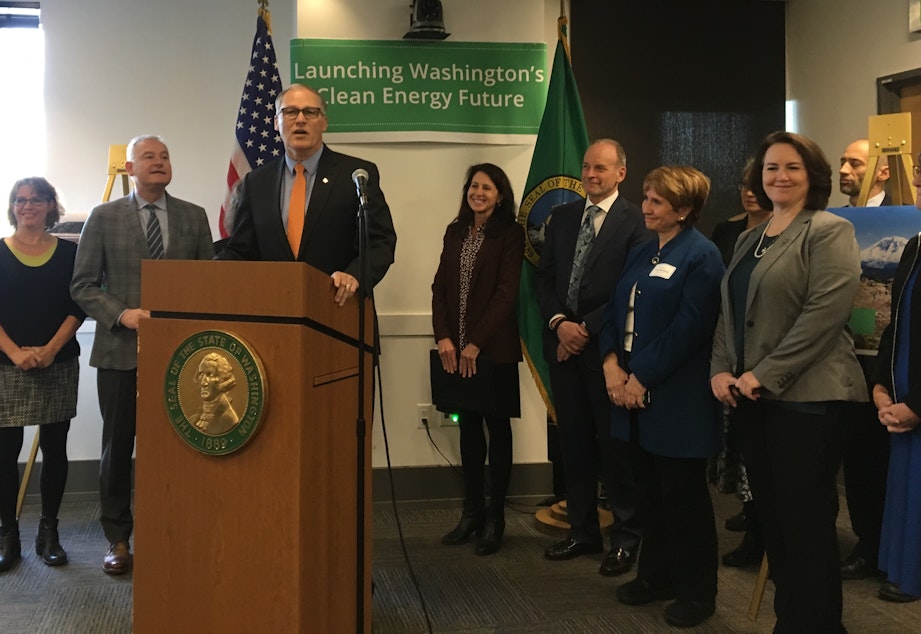Bold or tired? Inslee climate policy aims at decade-old goal

One month after Washington voters rejected a fee on carbon pollution, Gov. Jay Inslee is proposing a sweeping $268 million package of measures to rein in carbon emissions from power plants, cars and buildings.
“It is driven by something more compelling than the unquestionable science of climate change,” Inslee said of the effort to help stabilize the planet’s increasingly angry climate. “It is driven by a more powerful force — and that is love.”
At a press conference, Inslee called his proposal “the boldest, biggest leap forward in the fight against climate change in the history of this state.”
But despite Inslee's claim, his policies’ aims are not in line with the latest science of climate change — nor are they as ambitious as Seattle’s or California’s climate policies.
Report after dire scientific report has come out in 2018, with climate scientists warning that we need to stop burning the fuels that are overheating our planet.
To keep the planet from heating a disastrous 2 degrees Celsius or more, global carbon emissions would need to fall by 45 percent from 2010 levels by 2030 and hit zero around 2050, according to the latest Intergovernmental Panel on Climate Change report in October.
Sponsored
The U.N. scientific panel said such reductions “would require rapid, far-reaching and unprecedented changes in all aspects of society.”
Inslee, widely expected to make a run for the White House in 2020, has also been beating the climate drum.
"We climate hawks do not fear the world,” Inslee said Monday. “We lead it."
The clean-energy package Inslee unveiled Monday aims to cut Washington’s emissions 25 percent below 1990 levels by 2035 and halve them by 2050—goals set by the state in 2008.
California aims for a steeper, 80 percent cut by 2050. Seattle aims to eliminate its emissions by then, though the city is not on track to make that goal.
Sponsored
‘It's not enough’
While they welcomed Inslee’s proposals, some supporters from the environmental groups at Inslee's press conference said they were frustrated that the policy’s aims don’t match what climate scientists say is needed.
“It's not enough,” Gail Gatton of Audubon Washington said. “We definitely will need more than just this.”
"I think it will happen where there are people demanding it," she said.
Under Inslee's proposal, Washington would stay within pollution limits set a decade ago under Gov. Christine Gregoire.
Sponsored
“It is eminently clear we need to strengthen and tighten our statutory limits,” Inslee senior policy advisor Chris Davis said. He said legislators tried and failed to do so last year.
Inslee himself scoffed at the suggestion that his policies don’t crack down hard enough on civilization-threatening pollution.
“It's like asking Neil Armstrong, why'd you only go to the moon, right? Why didn't you go to Mars?” Inslee said. “We're going to the moon this year with this package.”
If the legislature enacts Inslee's policies and they achieve their goals, Washington still would not meet the newer standards of the 2015 Paris climate treaty, signed by every nation on Earth. The Trump administration is in the process of withdrawing the United States from the treaty.
Sponsored
‘It is like climbing Mount Rainier’
“We will need to take additional steps,” Inslee said. “It is like climbing Mount Rainier. You take the first step forward.”
Last year, Inslee and the governors of 13 other states announced they would adhere to the Paris climate accords even if the Trump administration pulled the nation out of the treaty.
“Governor Inslee needs to balance what is needed with what is acceptable politically at this time,” said Kristie Ebi, an epidemiologist at the University of Washington and co-author of a climate change report for the UN's Intergovernmental Panel on Climate Change.
While Inslee has failed to get climate policies through the legislature in the past, last month's election gives his Democratic Party a wider margin of control in Olympia.
“This package is developed this way so that it can pass this year because this is the 11th hour,” Inslee said.
Sponsored
“Washington already has a low carbon footprint,” Republican state Sen. Doug Ericksen of Ferndale said.
Rather than regulating local businesses, “we should be developing new technology and exporting it,” said Ericksen, who has two oil refineries in his district. “That’s how you’re going to influence what happens in China and India.”
100% clean power
Inslee’s cornerstone proposal would require all electricity sold in Washington to be carbon-neutral by the year 2030 and to have zero fossil-fuel content by the year 2045. Electricity in hydropower-rich Washington is currently 75 percent carbon-free.
A spokesperson for Puget Sound Energy, the state’s biggest seller of coal power, did not respond to a request for comment.
Other policies include:
• A cluster of proposals to make buildings — the state’s biggest source of emissions after transportation — more energy efficient.
• A "clean fuel standard" to make conventional cars and trucks 20 percent less polluting over the next decade.
• A phaseout of the refrigerants and powerful greenhouse gases known as HFCs.
The package’s most costly proposal, eating up nearly half its total cost, would build two all-electric ferries and convert two of the state’s largest ferries, the Wenatchee and the Tacoma, to electric-hybrid motors.
The state's fleet of 23 ferries burns an average of 19 gallons of diesel fuel per mile of travel.
Inslee’s policies do not address one of the fastest-growing sources of carbon pollution: aviation.
“We’re focusing on the places where we think we have the earliest opportunities to make progress,” Davis said.




